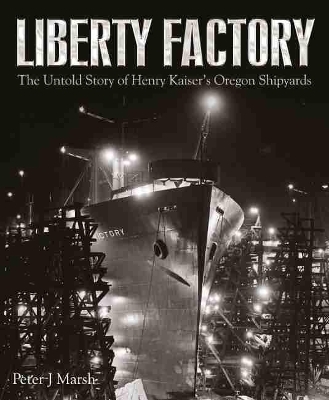
Liberty Factory
The Untold Story of Henry Kaiser's Oregon Shipyards
Seiten
2021
Seaforth Publishing (Verlag)
978-1-5267-8305-9 (ISBN)
Seaforth Publishing (Verlag)
978-1-5267-8305-9 (ISBN)
The extraordinary story of one of the keystones of victory in WW2. Largely inspired by British requirements so plenty of UK interest.
Churchill famously claimed that the only thing that had really frightened him during the war was the Battle of the Atlantic. Keeping open the lifeline between the US arsenal of democracy' and the UK was essential to preparations for the invasion of Europe and in the final analysis this came down to building merchant ships faster than German U-boats could sink them.
Crucial to this achievement was the British-designed Liberty Ship', a simple cargo ship that could be built rapidly, combined with the untapped industrial potential of the USA that could build them in vast numbers. Undoubtedly the most important individual in the rapid expansion of US wartime shipyard capacity was Henry Kaiser, a man with no previous shipbuilding experience but an entrepreneur of vision and drive. This book tells the story of how he established huge new yards using novel mass-production techniques in the most surprising location - Oregon, one of the least industrially developed areas of the US and one without an existing pool of skilled labour to draw on.
But it did have space, and large tracts of virgin waterfront were ideal for laying out new shipyards from scratch. The workforce was created by encouraging people from all over the US to move to the area, and to facilitate this the company built its own housing - in fact, a whole new city for 44,000 workers - and provided a level of social care unheard of in present-day America let alone in the 1940s. It was keen to recruit women workers so to encourage mothers to go out to work it also built its own schools and nursery facilities.
The result was a well-motivated workforce that turned the Kaiser yards into the most efficient shipbuilders in the country. In total Kaiser's Oregon yards built over 600 Liberties' and the follow-on Victory Ships' - including one built in the record time of 10 days - as well as around 150 tankers, some 50 escort carriers and nearly 100 amphibious warfare ships. Curiously, this truly remarkable achievement, of huge significance to the eventual Allied victory, has been consigned to the footnotes of history, but is fully documented and celebrated for the first time in this book.
Churchill famously claimed that the only thing that had really frightened him during the war was the Battle of the Atlantic. Keeping open the lifeline between the US arsenal of democracy' and the UK was essential to preparations for the invasion of Europe and in the final analysis this came down to building merchant ships faster than German U-boats could sink them.
Crucial to this achievement was the British-designed Liberty Ship', a simple cargo ship that could be built rapidly, combined with the untapped industrial potential of the USA that could build them in vast numbers. Undoubtedly the most important individual in the rapid expansion of US wartime shipyard capacity was Henry Kaiser, a man with no previous shipbuilding experience but an entrepreneur of vision and drive. This book tells the story of how he established huge new yards using novel mass-production techniques in the most surprising location - Oregon, one of the least industrially developed areas of the US and one without an existing pool of skilled labour to draw on.
But it did have space, and large tracts of virgin waterfront were ideal for laying out new shipyards from scratch. The workforce was created by encouraging people from all over the US to move to the area, and to facilitate this the company built its own housing - in fact, a whole new city for 44,000 workers - and provided a level of social care unheard of in present-day America let alone in the 1940s. It was keen to recruit women workers so to encourage mothers to go out to work it also built its own schools and nursery facilities.
The result was a well-motivated workforce that turned the Kaiser yards into the most efficient shipbuilders in the country. In total Kaiser's Oregon yards built over 600 Liberties' and the follow-on Victory Ships' - including one built in the record time of 10 days - as well as around 150 tankers, some 50 escort carriers and nearly 100 amphibious warfare ships. Curiously, this truly remarkable achievement, of huge significance to the eventual Allied victory, has been consigned to the footnotes of history, but is fully documented and celebrated for the first time in this book.
PETER J MARSH has born in Great Britain but has lived his adult life in Portland, Oregon. He is a journalist specialising in maritime subjects and is also a very knowledgeable local historian. He acquired the photographic collection of the local newspaper when it closed own and inspired by the superb wartime images - many reproduced in this book - he set out to find out more about an industry that has virtually disappeared without trace locally. This book is the result.
| Erscheinungsdatum | 06.03.2022 |
|---|---|
| Zusatzinfo | 100 black and white illustrations |
| Verlagsort | Barnsley |
| Sprache | englisch |
| Maße | 216 x 260 mm |
| Themenwelt | Natur / Technik ► Fahrzeuge / Flugzeuge / Schiffe ► Militärfahrzeuge / -flugzeuge / -schiffe |
| Sozialwissenschaften ► Politik / Verwaltung | |
| ISBN-10 | 1-5267-8305-3 / 1526783053 |
| ISBN-13 | 978-1-5267-8305-9 / 9781526783059 |
| Zustand | Neuware |
| Haben Sie eine Frage zum Produkt? |
Mehr entdecken
aus dem Bereich
aus dem Bereich
von der Machtergreifung bis zur Gründung der Vereinten Nationen
Buch | Softcover (2023)
Motorbuch Verlag
CHF 38,90


